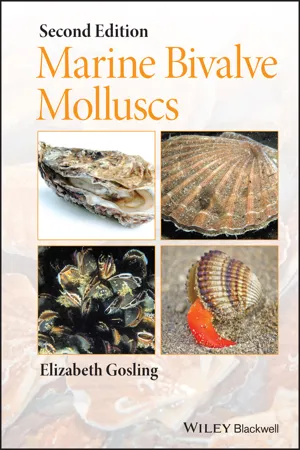
Marine Bivalve Molluscs
Elizabeth Gosling
- English
- ePUB (disponibile sull'app)
- Disponibile su iOS e Android
Marine Bivalve Molluscs
Elizabeth Gosling
Informazioni sul libro
Marine Bivalve Molluscs
Marine Bivalve Molluscs is a comprehensive and thoroughly updated Second Edition of Bivalve Molluscs, covering all major aspects of this important class of invertebrates. As well as being an important class biologically and ecologically, many of the bivalves are fished and cultured commercially (e.g. mussels, oysters, scallops and clams) in a multi-billion dollar worldwide industry.
Elizabeth Gosling has written a landmark book that will stand for many years as the standard work on the subject. Chapters in Marine Bivalve Molluscs cover morphology, ecology, feeding, reproduction, settlement and recruitment, growth, physiology, fisheries, aquaculture, genetics, diseases and parasites, and public health issues. A full understanding of many of these aspects is vital for all those working in bivalve fisheries and culture.
An essential purchase for anyone concerned with this important class of animals, copies of Marine Bivalve Molluscs should be on the shelves of biologists, ecologists, environmental scientists, fisheries scientists and personnel within the aquaculture industry. Copies of the book should be available in all libraries and research establishments where these subjects are studied or taught.
REVIEWS OF THE FIRST EDITION
An admirable achievement…a valuable addition to marine sciences libraries everywhere. The back cover of this book says that it is a landmark text that will stand for many years as the standard work on this subject. I can only agree with this sentiment.
~ Aquaculture
A welcome addition to the literature and provides the reader with a comprehensive overview of biological and environmental factors that affect and control both natural populations of marine bivalves and culture operations.
~ Aquaculture International
The author has done an admirable job in compiling a wealth of information into a readable text.
~ Transactions of the American Fisheries Society
Will serve well as a description of much of both the experimental biology and the aquaculture of bivalves.
~ Journal of Experimental Marine Biology and Ecology
Provides excellent reviews of all major aspects…an extremely important reference for anyone engaged in bivalve research, fisheries management, and aquaculture.
~ Quarterly Review of Biology
The book is very readable, in an easy style. It is well illustrated and there is a wealth of data and statistics presented.
~ Bulletin of the Malacological Society of London
Domande frequenti
Informazioni
1
Phylogeny and evolution of bivalve molluscs
Molluscs range from limpets clinging to rocks, to snails which crawl or dig or swim, to bivalves which anchor or burrow or bore, to cephalopods which torpedo through the water or lurk watchfully on the bottom. They penetrate all habitats: the abysses of the sea, coral reefs, mudflats, deserts, and forests, rivers, lakes and under ground. They may become hidden as parasites in the interior of other animals. They feed on every possible food and vary in size from giant squids and clams to little snails a millimetre long.
Phylogeny of the Mollusca
